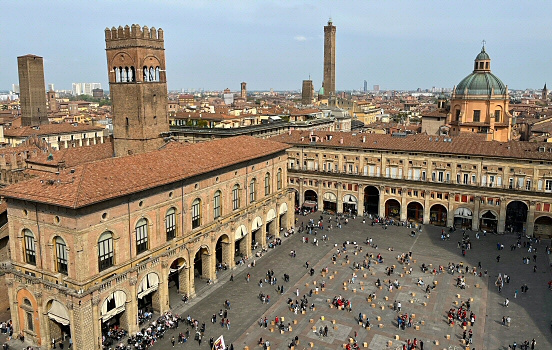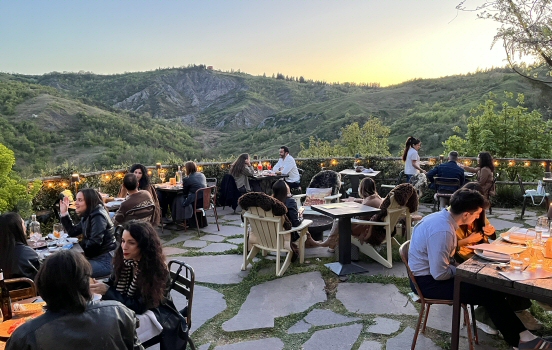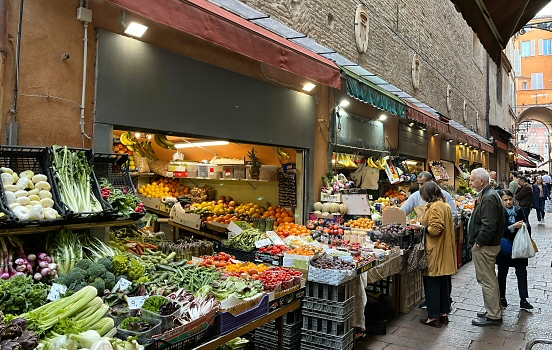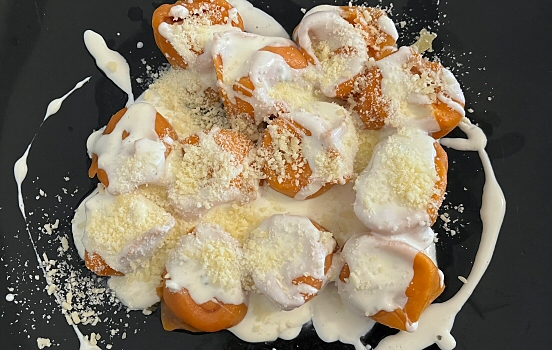The lush region Emilia-Romagna is wedged between the steady Po river in the north and the grip of the Apennines in the south. Its fertile terroir of the longest river in Italy joins forces with the micro climate from the valley winds to create a culinary pride of epic proportions.
Each town in this region clings to its signature dish like a badge of honor. Parma boasts prosciutto with a legendarily slow cure. Modena’s balsamic vinegar is thick enough to anoint a king. The pumpkin-filled cappellacci are more than pride in Ferrara. Mess with any of it and you’ll be chased out of town. And then there’s Parmigiano Reggiano in every corner, arguably the world’s greatest and most versatile cheese (at least if you ask me).
We stopped earlier for lunch in Marradi, a tiny mountain village nestled in the Apennine. The restaurant owner introduced us to her mother in the kitchen who created magic on the plates and wouldn’t let us leave before surrendering to her dessert specialty. Resistance was futile.
 Piazza Maggiore is the beating heart of Bologna.
Piazza Maggiore is the beating heart of Bologna.
But today I am in Bologna, the undisputed food capital of Italy. It’s a youthful city thanks to the university, claimed to be the oldest of its kind in the world. The hearts of the locals vote with a color as red as the bricks holding the city together.
Bologna is the city where every street smells like dinner. As expected, it is proud to be the home of several tasty delicacies, such as mortadella, tortellini and of course Ragu alla Bolognese. To be on the safe side, I order all of it. Beyond delicious. The Italians even have a word for wiping up the last remnants of sauce with bread. Scarpetta, like poetry for my taste buds.
To top it all off, I have a divine espresso sitting under the azure sky, accompanied by a gelato which make me grin like Jack Nicolson. Italy takes food and dining experience to the next level.
 Wonderful dinner in the hills south of Bologna.
Wonderful dinner in the hills south of Bologna.
The Italian obsession with food is charmingly absurd. It’s of course tasty and beautiful with a focus on amazing ingredients in season, but there is another side to it. Food in Italy is also infamously conservative. There can be a bitter feud between neighboring villages whether a certain recipe should include pancetta or not.
 Abundance of produce in the alleys of Bologna.
Abundance of produce in the alleys of Bologna.
But here’s the irony: Italian cuisine is arguably not as traditional as the Italians would have it. One of the most vital Italian ingredients is the tomato, but it was not actually introduced until the 15th century, when it was brought back from the Americas and quickly became a permanent fixture.
 Love on a plate in Marradi.
Love on a plate in Marradi.
Even something so synonymous to Italian food as spaghetti was supposedly brought to Sicily by the Arabs in the 12th century, and it didn’t spread to northern Italy until a hundred years ago. Just don’t mention it to the nonna or she might add gorgonzola to your cacio e pepe.
“When somebody’s offering you food, they’re telling you a story. They’re telling you what they like, who they are. Presumably, it’s a proud reflection of their culture, their history, often a very tough history. You turn your nose up at that important moment, the whole relationship changes, and it will never be the same.”
— Anthony Bourdain
Comments
No comments yet.
Leave a reply